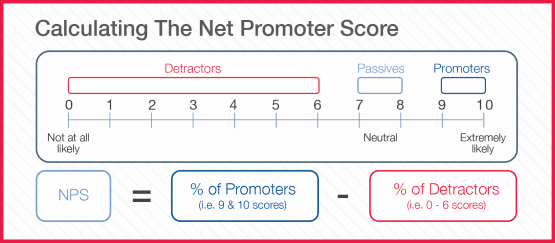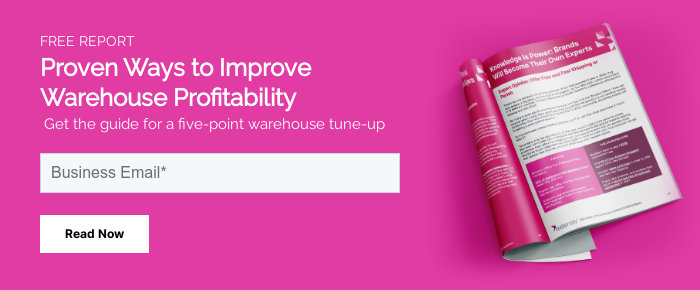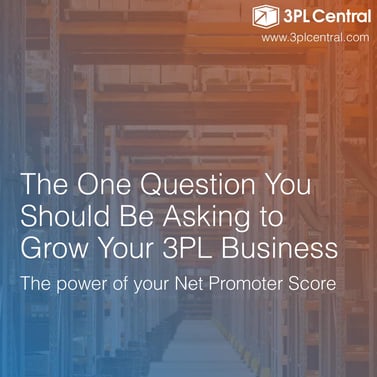The One Question 3PLs Should Be Asking to Grow Their Business
3PL warehouses looking to grow should always focus on their customers’ satisfaction first. Happy customers remain loyal, write great reviews, and even refer new prospects. The last two are especially important because word-of-mouth recommendations are the most trusted source of advertising for 83% of all respondents of the Nielsen Global Trust in Advertising Report1.
Yet, many 3PLs may not know where they truly stand with their customers. The good news is that there is a way to find out and it starts with perhaps the single most important question your 3PL should be asking your customers:
“How likely is it that you would recommend our company/product/service to a friend or colleague?”
That question is actually the basis for one of the most critical ratings in the business world today – your company’s “Net Promoter Score” or NPS. NPS assumes that more than just customer satisfaction, a customer’s willingness to likelihood to recommend a service to a friend is the single most important indicator of customer loyalty, and is correlated directly with success. Used by more than two-thirds of Fortune 1000 companies, NPS is a useful predictor of growth among competitors2. In fact, according to the book “The Ultimate Question 2.0” by Fred Reichheld, companies that score highly in NPS outgrow their competitors by an average of 2.5 times3.
While metrics like inventory turnover ratio or On-Time In Full (OTIF) delivery are important benchmarks to have, it doesn’t matter as much if your customers aren’t happy in the end. You may still lose the business to competitors, fail to get referrals, and, without insight into your customers’ experience with your service, struggle to grow.
To ensure that your 3PL business has a full understanding of this important standard, Extensiv has created a simple guide for you to follow so you can become an expert on how to manage your customer experience and satisfaction. As an added bonus, download our sample template and find out your NPS score today.
What is a Net Promoter Score (NPS)?
As a customer of any company yourself, you may have received requests for follow-up surveys via phone or email regarding your experience with a transaction - that’s the NPS at work. More than a way to track customer satisfaction, it is a metric for customer experience as a whole, and how successful you are in building a relationship with your customers. NPS is a management tool that can be used to gauge the loyalty of a firm's customer relationships and a way to measure customer experience. It serves as an alternative to traditional customer satisfaction research and has been correlated with sustainable revenue growth.
How Does NPS Work?
NPS is based on your customers’ responses to the aforementioned question: “How likely is it that you would recommend our company/product/ service to a friend or colleague?”. This question is usually sent as a survey to a list of customers via email.
The scoring for this answer is based on a 0 to 10 scale, with a follow-up question to expound on their answer: “What is the most important reason for your score?”
Once all results have been gathered, the customers will be segmented as follows:
Those who respond with a score of 9 to 10 are called Promoters who can solicit referrals, future business, and feedback to improve your business.
Responses of 7 and 8 are labeled Passives, as their behavior falls in-between4 and can easily be swayed by competitive offers.
Those who respond with a score of 0 to 6 are labeled Detractors who can become reluctant customers.
How Do You Calculate Your Net Promoter Score?
Your Net Promoter Score is calculated by subtracting the percentage of customers who are Detractors from the percentage of customers who are Promoters. Passives count toward the total number of respondents, thus decreasing the percentage of detractors and promoters and pushing the net score forward5.
NPS = % of promoters - % of detractors
So, if you surveyed 10 customers, and eight were promoters and two were detractors, 80% would be promoters, and 20% would be detractors. The formula for your NPS calculation would be:
NPS = 80% - 20% = 60

A Net Promoter Score can be as low as −100 (where everybody is a detractor) or as high as +100 (where everybody is a promoter). An NPS that is positive (i.e., higher than zero) is felt to be good, and an NPS of +50 is excellent.
The 2016 NPS Benchmarks Survey Report by CustomerGauge reveals that Transportation and Logistics companies have a 50% or more Net Promoter Score on average.6
Why Is Your NPS So Important?
We live in an age where the customer is king. Your 3PL clients today have more options than ever before – making them more likely to switch providers if they are unhappy. This is true with almost every business today.
What’s more, customers now have far more ways of broadcasting their feelings to the rest of the world. These include multiple social media properties, as well as formal ranking services like Yelp and Google Ratings. This is great news if your customers are happy. But can be not so great if they are not satisfied. In fact, a recent America Express study found that customers were three times more likely to share a bad review than a good one.
The second part of the NPS survey, where customers are asked to expound on their rating by answering “What is the most important reason for your score?”, is just as important in bringing the voice of your customer to the front. Asking an open-ended question provides customers the permission, to be honest in their feedback. Constructive criticism is important as it provides a deeper understanding of issues that your customers face on a daily basis, which gives you the right tools to handle their and future customers’ expectations moving forward. You also get exposed to errors your 3PL can correct quickly, and adjustments to your workflow that you would not have thought about before.
How Zappos Used the NPS score to become a billion dollar company in 2008
Zappos, the B2C online shoe and clothing retailer, is known for exceptional customer service (their longest customer service call on record lasted 10 hours and 29 minutes), and they often refer to themselves as a “Service Company that Happens to Sell Shoes.” CEO Tony Hsieh attributes their success to their customer-centric culture that encourages going above and beyond for their customers, and using NPS to gain constructive feedback about how to do better every day – and actually following that feedback. In 2017, their Net Promoter Score was 83% for online surveys and 93% after talking to a representative. Their NPS is one of the highest across all industries.
“It’s all about delivering happiness to customers and employees. And fun is one element of what makes people happy. At Zappos, we use NPS every day to make sure we’re WOWing both our customers and our employees.” – Tony Hsieh, CEO at Zappos
And it works – Zappos earned their first billion in 2008, two years earlier than predicted, and got acquired by Amazon for $1.2 billion in 2009. They’ve been growing steadily and wowing customer feedback ever since.
What is a Good NPS Score For a 3PL?
3PLs are still relatively new to the world of NPS. As such, there is a lack of consistent public data for our industry. And the data that is available can vary widely. Some monitoring groups have reported an average logistic industry score of “56”8 – whereas others say our NPS industry average is “0”9.
This erratic information makes it difficult for a 3PL to compare itself directly to its competition. But in the NPS and customer satisfaction world, the most important comparison is not with your competition - but with yourself and your own performance10.
The best benchmark for your 3PL, therefore, should be your NPS score from last year.
How Can I Use My Net Promoter Score to Grow my 3PL?
Knowing and tracking your 3PL’s Net Promoter Score can have a huge impact on your ability to grow for the following reasons:
- Your NPS will tell you where you truly stand with your customers. NPS provides a standardized method of measuring client satisfaction. It will give your 3PL the unvarnished truth – which will help you improve.
- Your NPS enables you to identify your “promoters” and “detractors.” This is invaluable to know, as it will let you know what you are doing right – while helping you to open a dialogue with those who are not yet fans.
- Determining your NPS can allow you to better position yourself with your customers. You may not wish to reveal your score to them (as your B2B score will likely be lower than their own). But the instant you ask them the “would you recommend” question, any NPS-savvy consumer company will know why. This will show that you care – and speak their language.
- Use your score to promote yourself. If you do record a tremendous score (say a 50+), then you would want to use it to promote your services. You may also be able to use your score as a means of comparison if more industry-wide data on 3PL NPS scores become available in the future.
- Build a Plan to Improve. Knowing your NPS score will offer your 3PL business the knowledge of where you need to develop a plan to track, measure, and improve your customer experience and convert your Detractors to Promoters.
Three Simple Guidelines To Cash in on NPS
In order for your warehouse to capitalize on the simplicity of implementing NPS across your business, follow these three rules:
- Transparency. Results must be transparent, consistently compiled, and communicated with all teams members so your warehouse staff can take action and track your results.
- Closed-Loop Learning. Building new learning and improvement processes allow 3PL staff to bake in a positive customer experience into daily operations. Knowing where you need to close the gaps will offer your business the opportunity to improve service to once again track results.
- Mission Critical. Growth-minded 3PL owners and business leaders must make NPS a relevant part of the business. The creation of Promoters for your 3PL warehouse must be a top-level initiative.
We hope this overview of Net Promoter Scores will give your 3PL insights into new ways it can improve its customer satisfaction levels and grow. For more information about how you can expand your clientele and profitability, download our “Practical Guide to Growing Your 3PL Warehouse.”
- Net promoter score benchmarks
- Net Promoter
- Ultimate question drives transportation insights growth
- Net-promoter-score
- Net promoter score NPS
- Good net promoter score
- Infographics
- Logistics
- XPO logistics
- What is a good net promoter score









